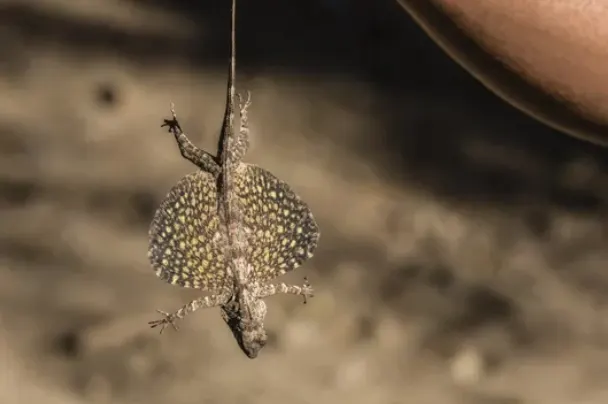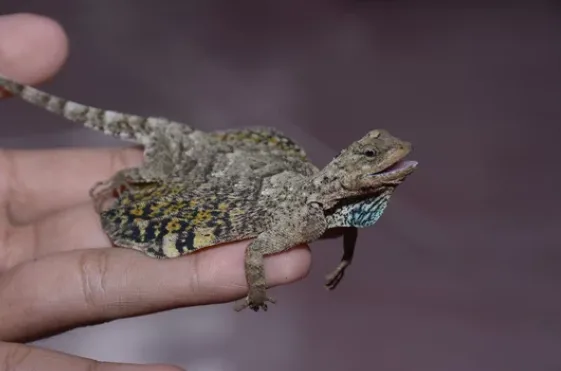Imagine gliding through the treetops like a dragon! That’s exactly what the Draco Volans, commonly known as the “Flying Lizard,” does every day. Found in the lush forests of Southeast Asia, these fascinating creatures use their wing-like structures to soar from tree to tree. Let’s explore the unique world of Draco Volans and uncover what makes this lizard such an incredible species.

Table of Contents
What is Draco Volans?
Draco Volans, meaning “Flying Dragon” in Latin, belongs to the Agamidae family, which includes about 45 different species of flying lizards. While it’s often called a flying lizard, Draco Volans doesn’t technically fly — it glides. This impressive ability is thanks to the patagia, special membranes that stretch out from their ribs to create wing-like structures. These wings let them glide distances of up to 26 feet from tree to tree!
Fascinating Facts About Draco Volans
- A Flying Illusion: Despite their nickname, Draco Volans can’t truly fly. They glide using ribs that extend to form a wing-like structure, giving the illusion of flight.
- Time to Glide: Draco Volans has a routine! It’s most active in the morning between 8:00 and 11:00 a.m. Afterward, it takes a break until around 1:00 p.m., avoiding the hottest part of the day.
- Nature’s Winged Wonder: Their “wings” are not just useful for gliding. The male’s wings feature blue tinges, while females have yellow highlights, adding to their charm.
- Camouflage Master: With their brown, tan, and blue coloration, Draco Volans can blend into the trees they inhabit, making them difficult to spot by predators.
Physical Appearance
Draco Volans may be small, but its appearance is striking. Males grow up to 7.7 inches long, while females can reach 8.35 inches. The body is slender, and the wings are what set them apart from other lizards. These wings, or patagia, are supported by elongated ribs. Males have blue-tinged wings, while females display a yellow hue.
In addition to their wings, Draco Volans has another distinct feature – the dewlap, a flap of skin under the throat. This dewlap is used for flight control and to attract mates. Males sport a bright yellow dewlap, while the female’s is a soft blue.
Behavior and Lifestyle
Draco Volans is a solitary creature, with males being very territorial. Each male claims a couple of trees, marking his territory and ensuring that no other males come near. These trees house a few females, making them a small, isolated community.
Males spend their entire lives in the trees, gliding from branch to branch. Females, on the other hand, will leave the trees only when they need to lay eggs. Interestingly, Draco Volans doesn’t use its gliding abilities to escape predators. Instead, it relies on its speed and camouflage to hide among the trees.
They are also creatures of habit, gliding during good weather and avoiding any flight when the weather turns bad. The treetops are their haven, and they rarely descend to the ground unless absolutely necessary.
Where Draco Volans Lives
Draco Volans is found in the tropical rainforests of Southeast Asia, including southern India, Borneo, and the Philippines. These lizards prefer areas with second-growth forests and forest edges, which provide ample space for gliding between trees.
Their habitat plays a significant role in their survival, as they need tall trees and a dense canopy to thrive. The abundance of trees allows them to glide effortlessly from one location to another without having to descend to the forest floor, where predators lurk.
What Does Draco Volans Eat?
Draco Volans has a simple yet efficient diet. It feeds mostly on termites and ants. These small insects make up the bulk of its diet, and the lizard doesn’t waste much energy hunting for them. Instead, it perches on a tree trunk or branch and waits for its prey to come close. Once an insect is within reach, Draco Volans uses its lightning-fast reflexes to snap it up. Occasionally, they will venture to the ground to forage, but this is a rare sight.
Predators and Threats
Being a small lizard, Draco Volans has its share of predators. It is hunted by larger animals such as birds of prey, tree snakes, and larger reptiles. Though it doesn’t rely on gliding to escape these predators, Draco Volans is quick and uses its coloring to blend in with the surrounding branches and leaves.
Interestingly, Draco Volans is not hunted by humans for
Reproduction and Life Cycle
When it comes to reproduction, Draco Volans follows a seasonal pattern. Mating occurs in the winter months, when the weather is warm but not too hot, and the monsoon season begins. Males will display their dewlap and circle a female three times before mating. If the female is interested, mating will take place. If not, she’ll signal her disinterest by displaying her wings and dewlap.
After mating, the female will descend from the trees to lay her eggs. She digs a small hole in the soil, deposits up to five eggs, and then covers them with dirt. She’ll guard the nest for about 24 hours before abandoning it. The eggs will hatch after 32 days, with the young lizards receiving no further care from the parents.

Draco Volans in the Wild: A Conservation Perspective
The conservation status of Draco Volans is currently listed as Least Concern by the International Union for Conservation of Nature (IUCN). Although their population size is not known, they are still abundant in their native habitats. The primary threats to their population are habitat destruction and the pet trade.
Draco Volans, with its unique gliding ability, striking appearance, and fascinating behavior, is truly one of nature’s marvels. This tiny lizard, with its dragon-like wings, captivates the imagination and continues to thrive in the dense forests of Southeast Asia. As we continue to learn more about these flying lizards, we can appreciate the intricate balance of nature that allows creatures like Draco Volans to glide gracefully through the trees.
- Enchi Ball Python: A Unique and Stunning Morph of Python regius - March 27, 2025
- Emerald Tree Monitor: The Enigmatic Green Guardian of the Rainforest - March 26, 2025
- The Egyptian Cobra (Naja haje): A Fascinating Serpent - March 25, 2025
